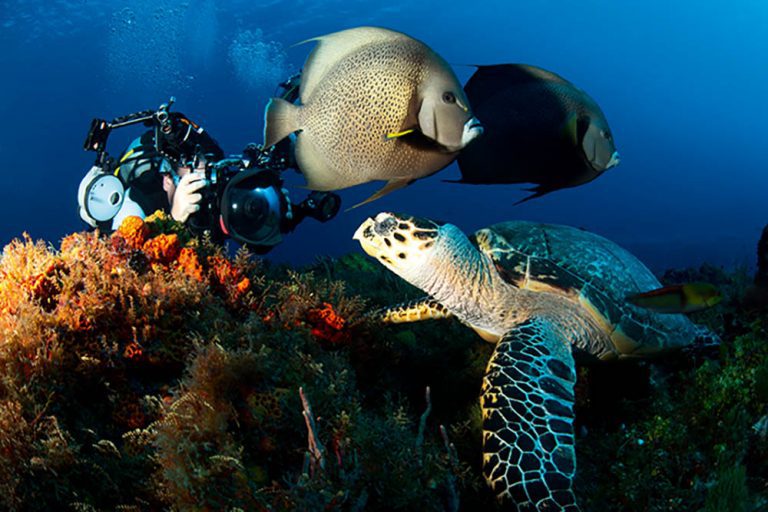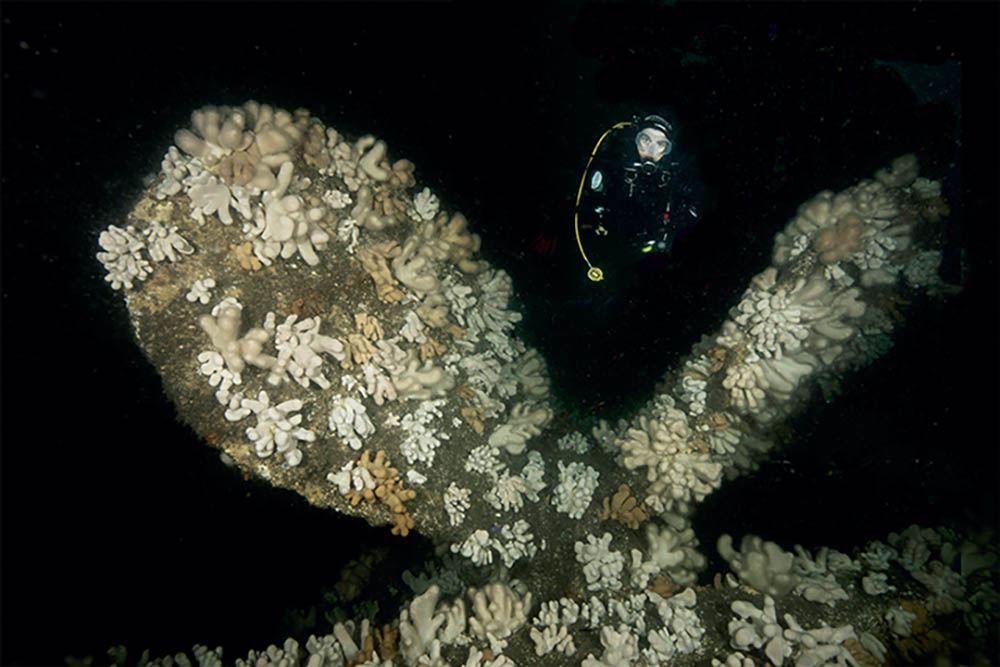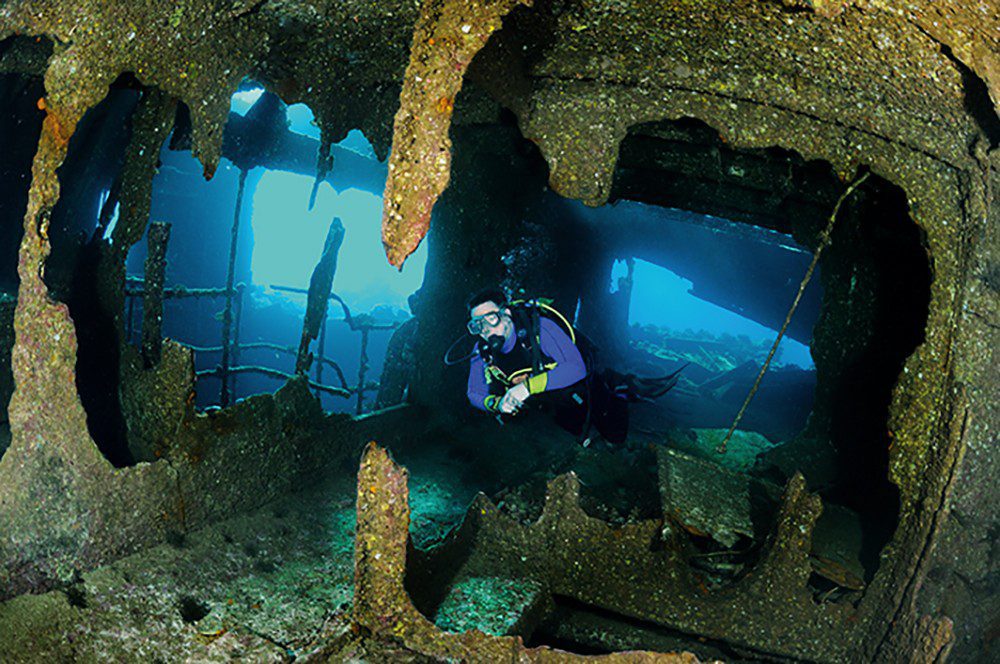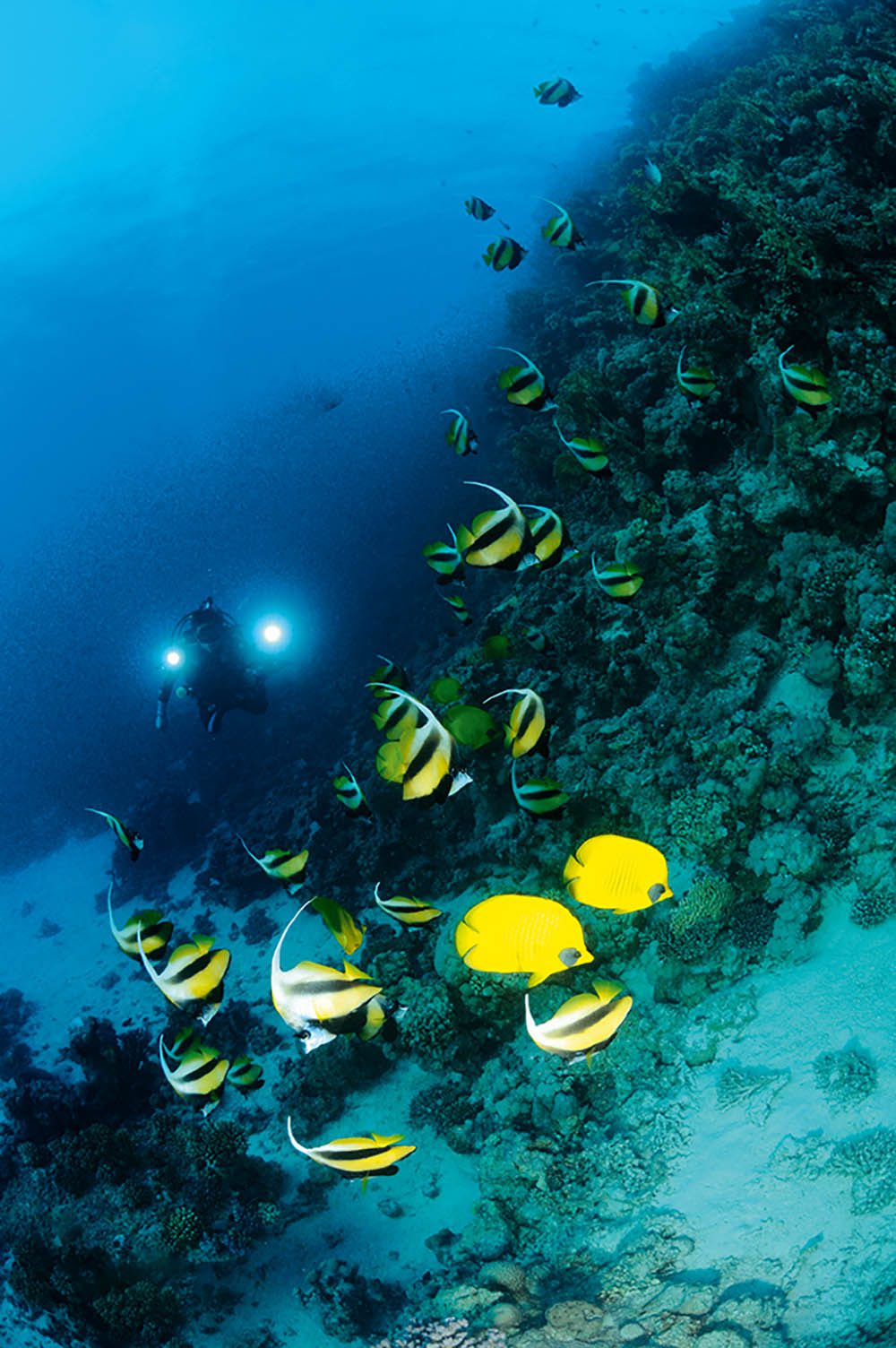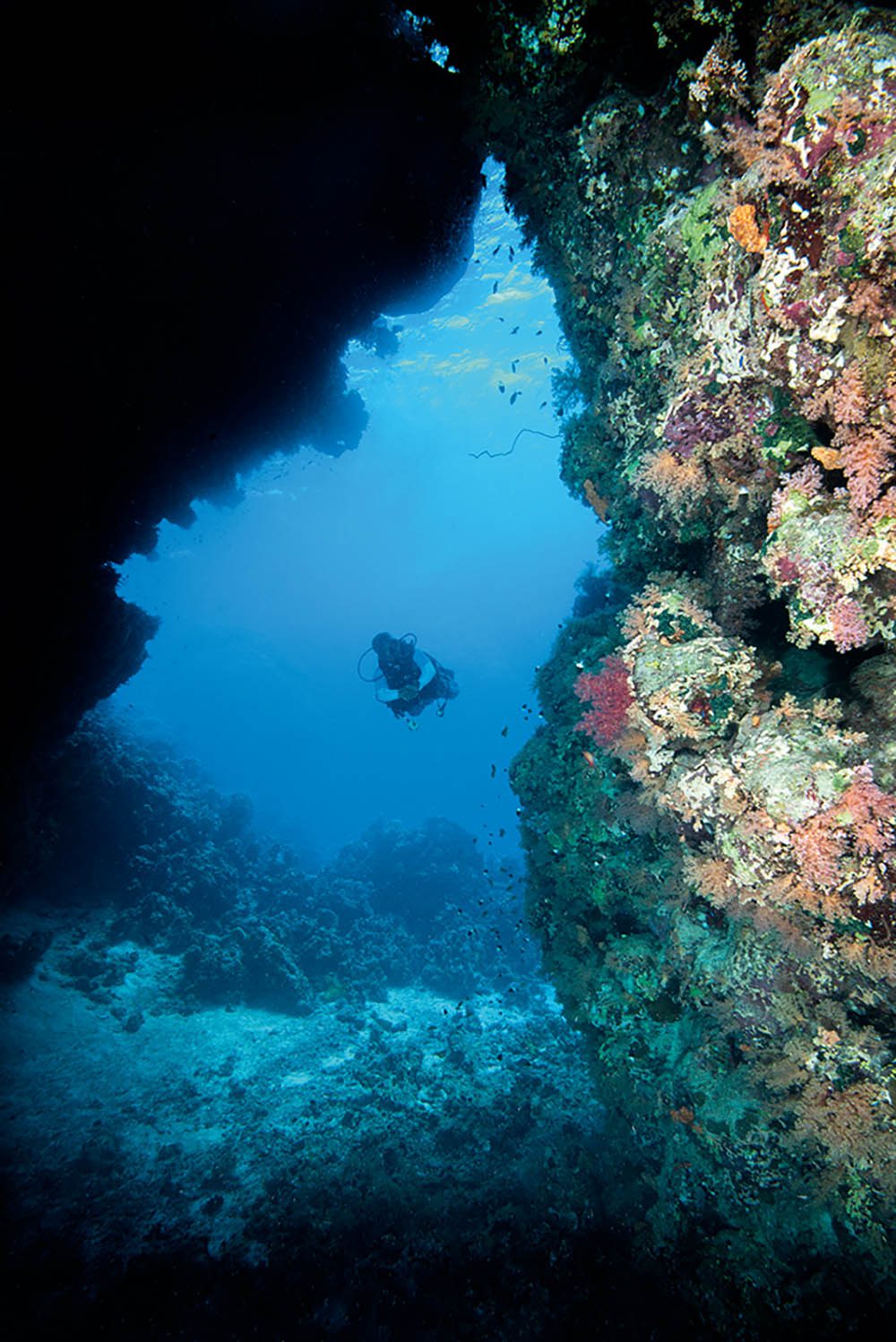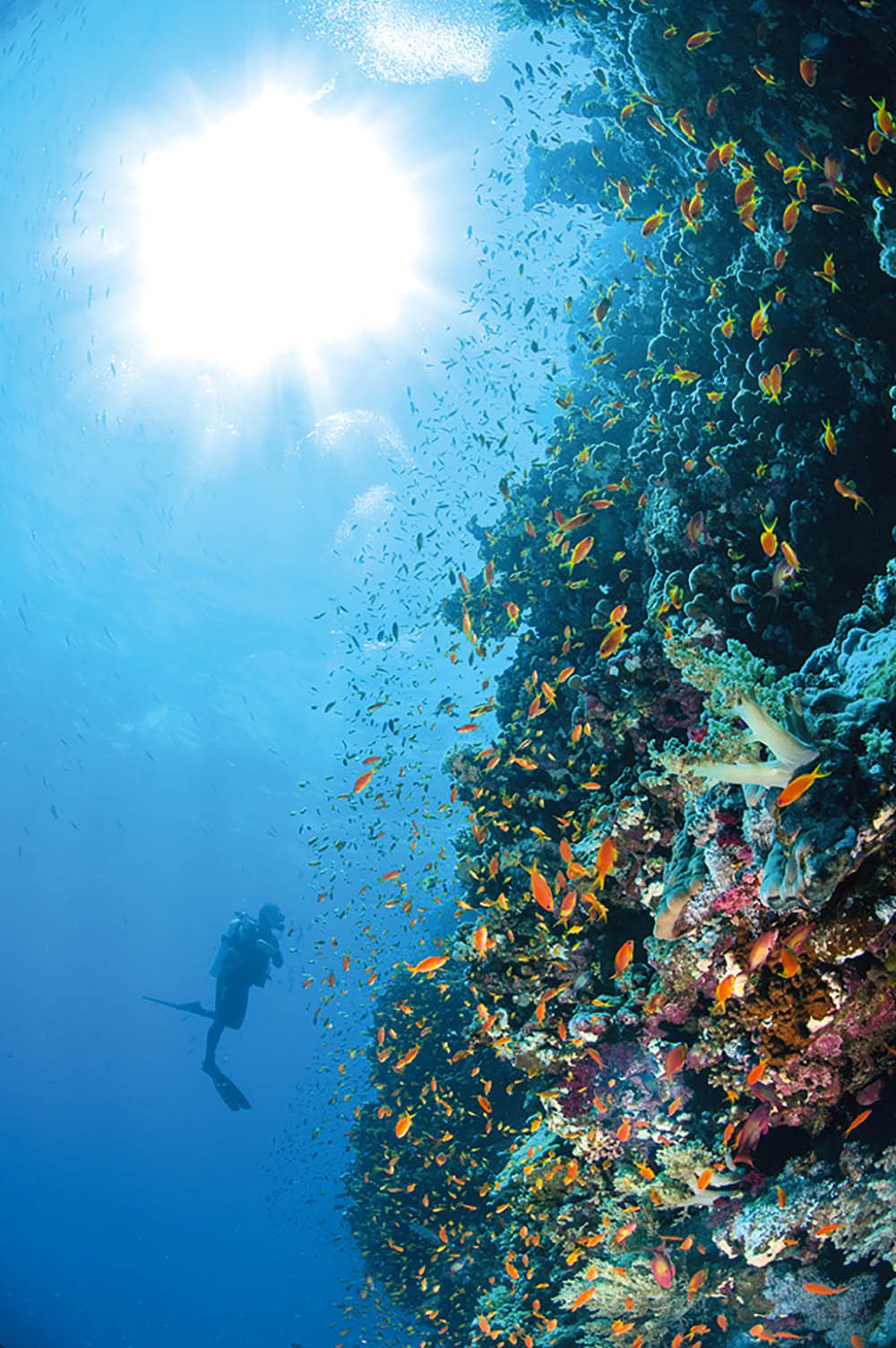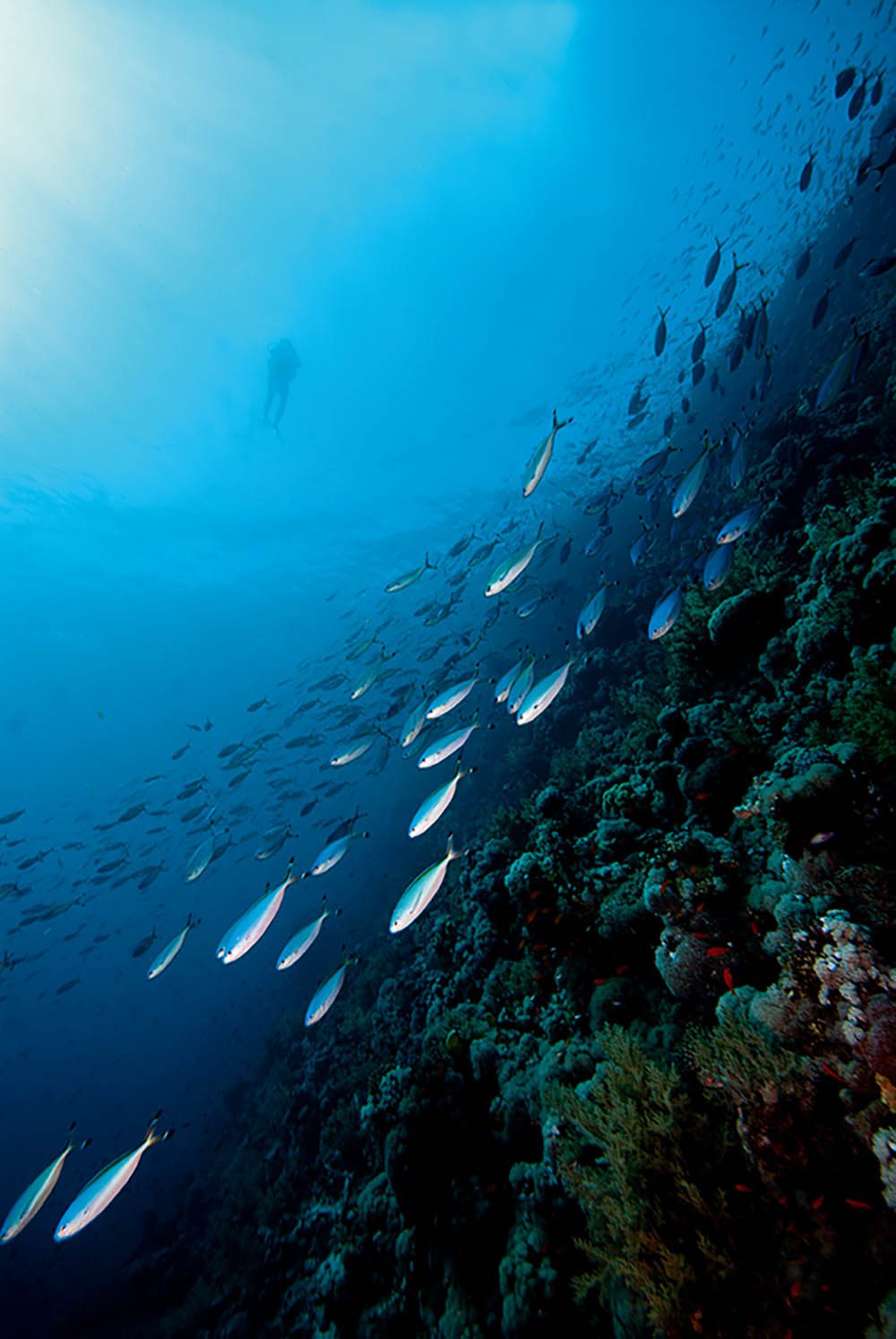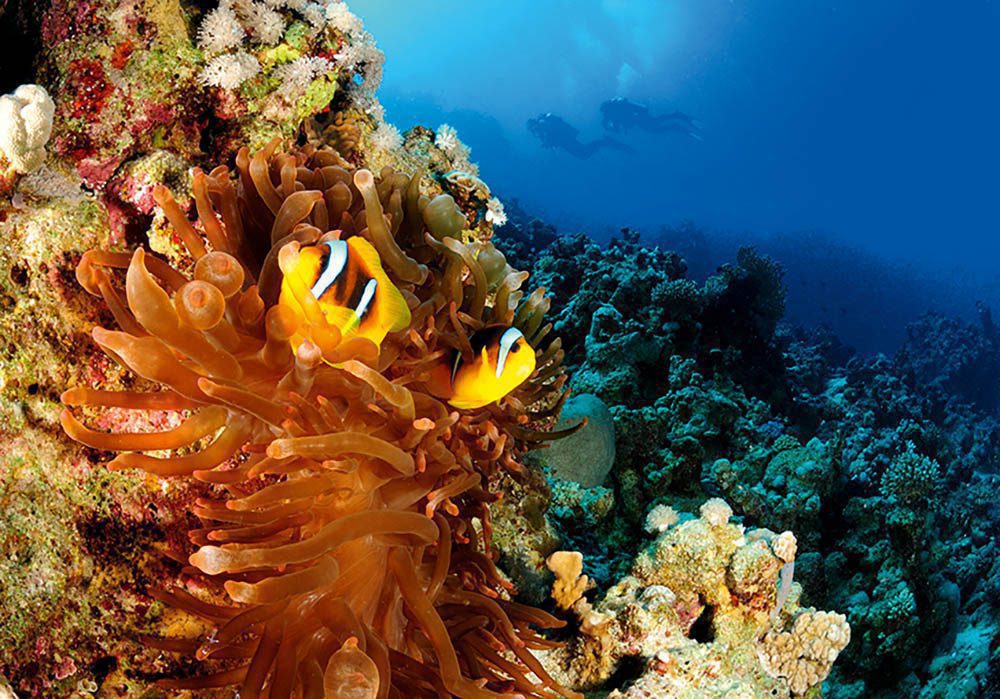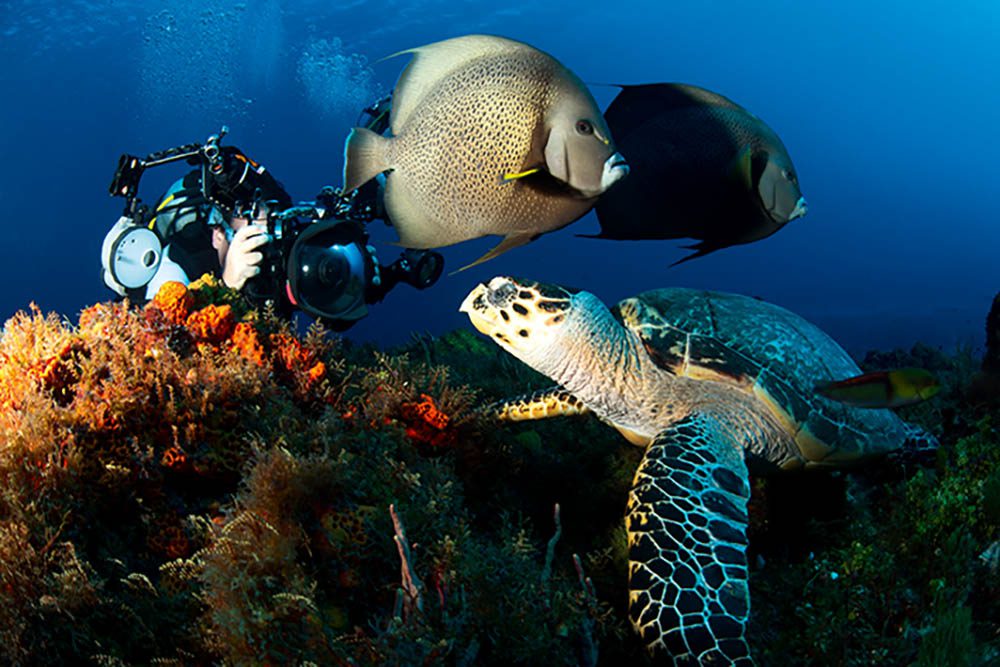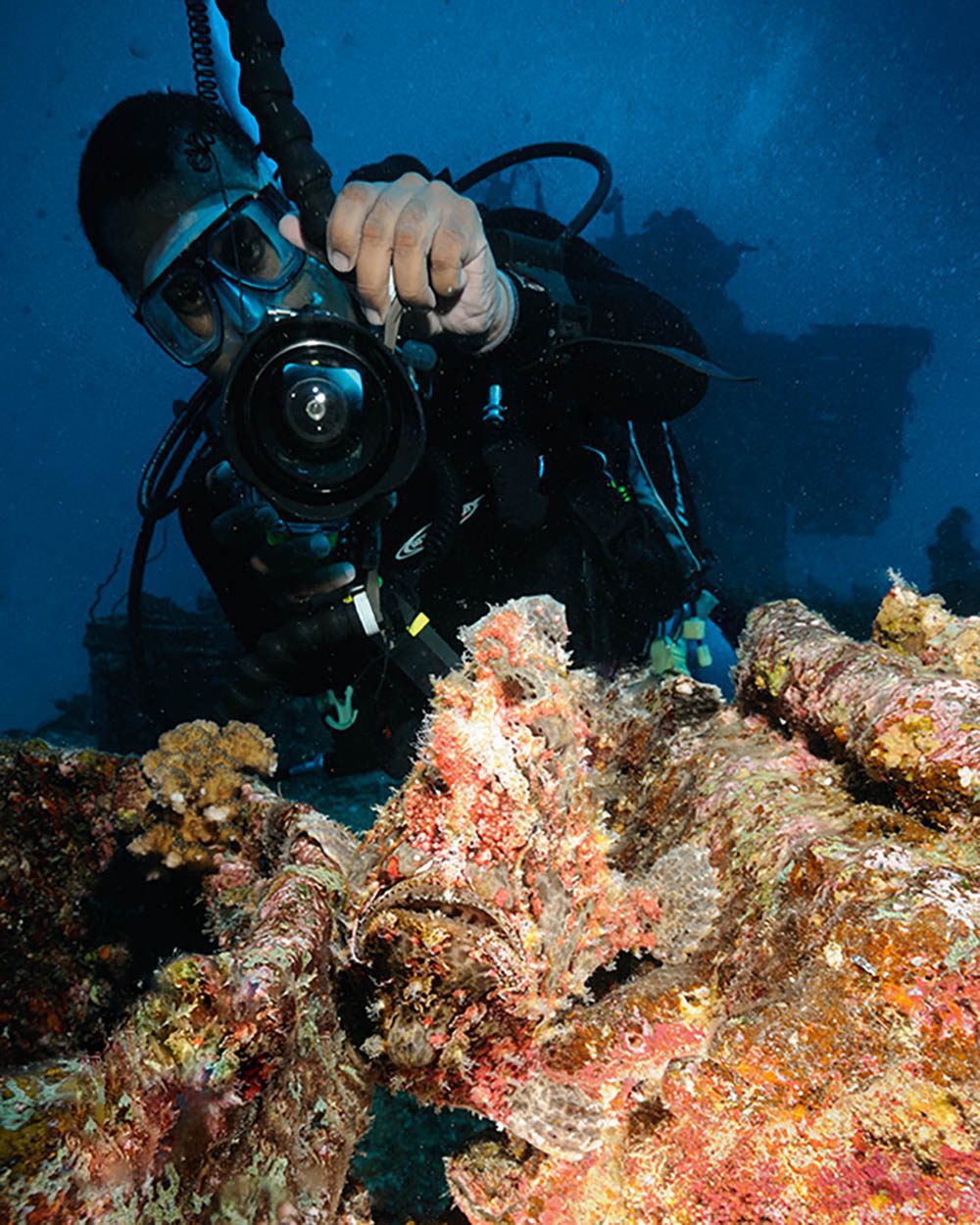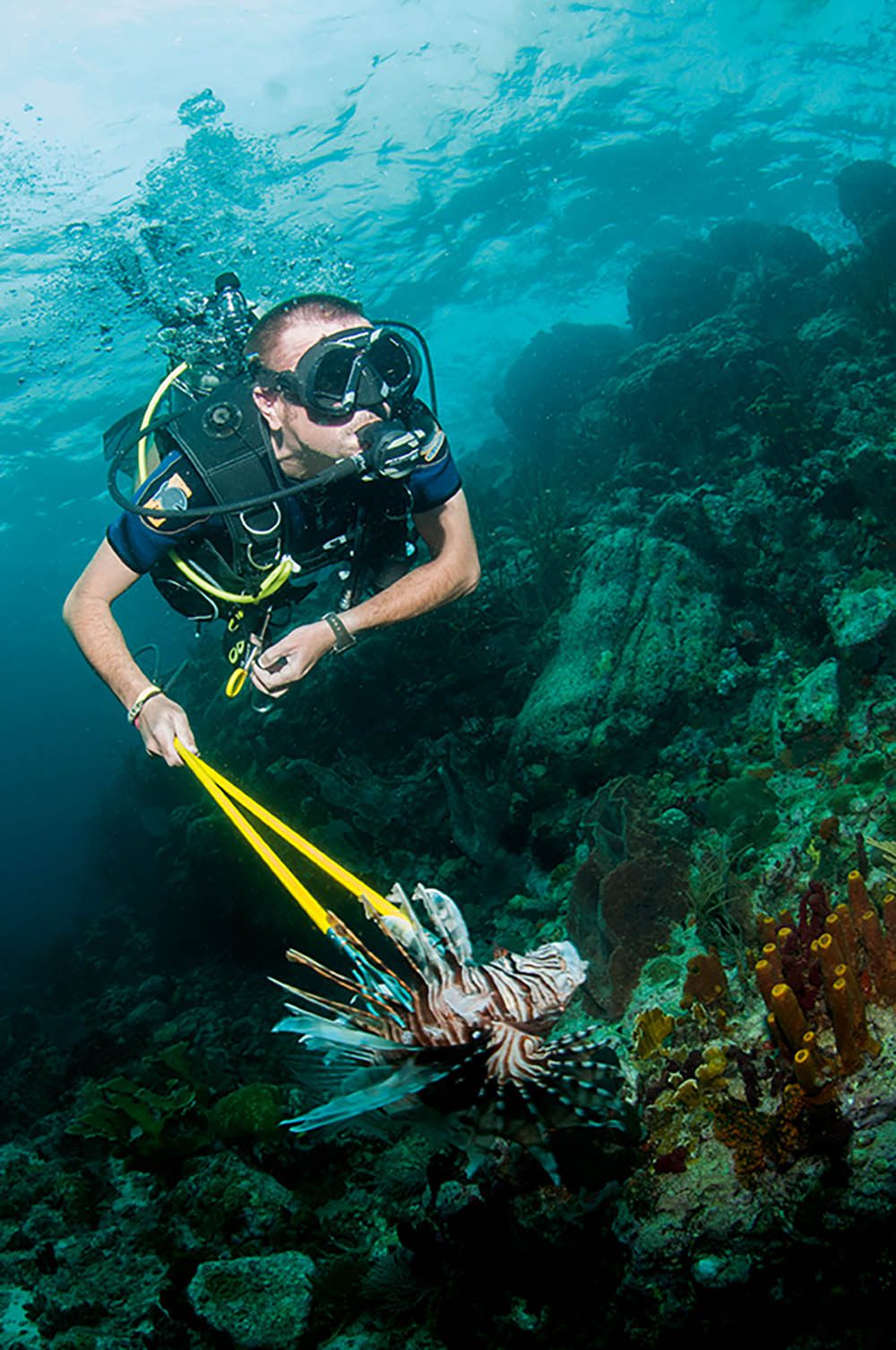BIG ANIMAL DIVER
People Who Need People
Human beings are big animals, of course, but for a long time RICHARD ASPINALL considered other divers more of a nuisance than a photo-opportunity. ‘I was wrong!’ he admits now
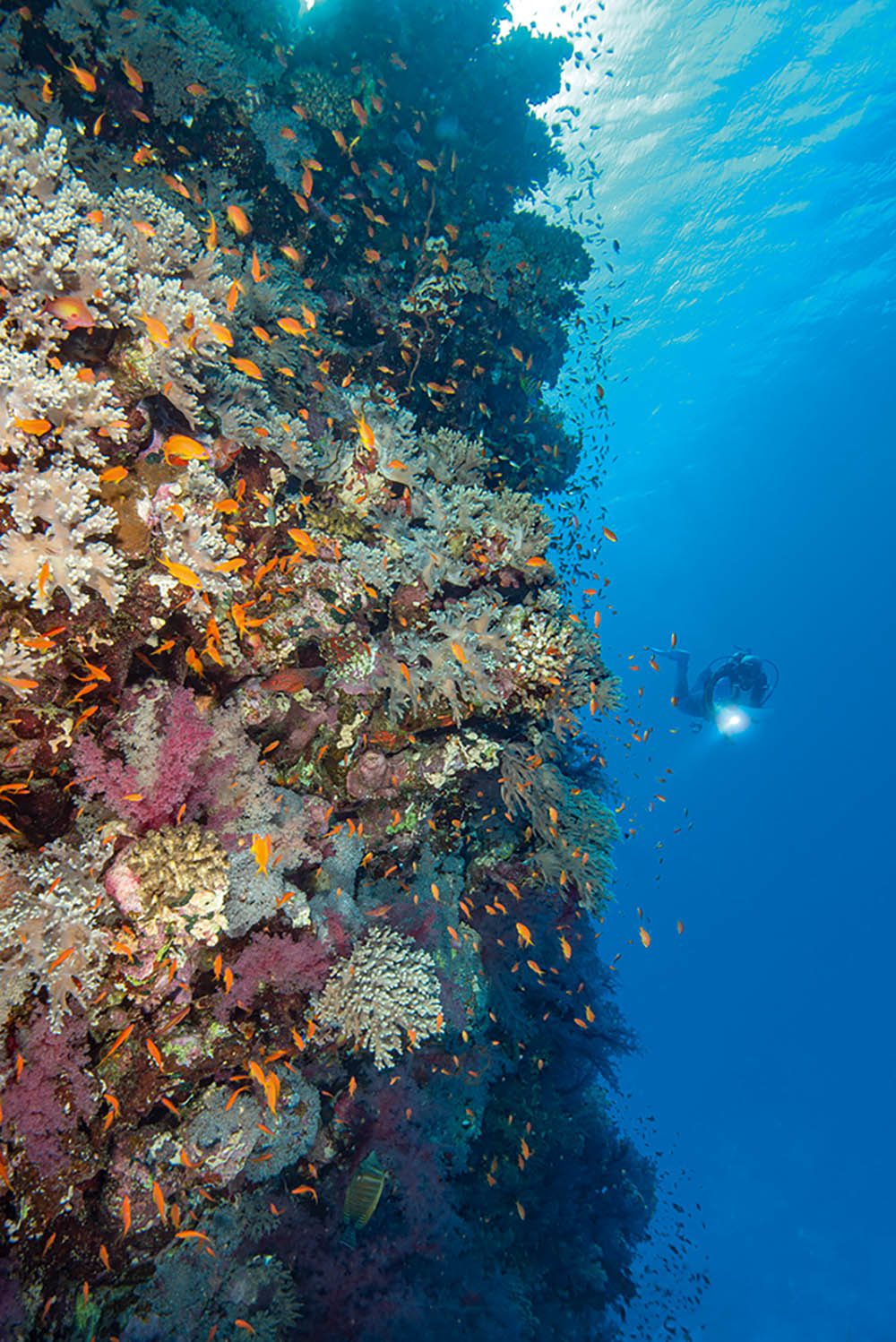
Appeared in DIVER July 2019
I’ve had to learn a number of lessons over the years: from the technical aspects of photography in a medium that’s not entirely friendly to complicated electronics, to the less immediately obvious, such as predicting the behaviour of a school of fish, or judging just when a shark will change direction and disappear into the blue.
Capturing the right shot sometimes comes down to being in the right place at the right time and doing the right thing with the camera.
While this might pass for a superficial definition of what makes an adequate photographer, taking a series of usable underwater images requires a little more. I realised that my wildlife and reef shots were fine, but that I needed to put people in the frame.
Commercial underwater photography is a business, after all. Magazines want to shift copies or drive online traffic. Everyone from liveaboard operators to tourist boards want to attract income and might require a suite of images to use on social media, brochures or to accompany press releases. Images likely to get the most use are those that say to the audience: “This could be you!”
It took me some time to learn this lesson. For years I would curse through my regulator (it’s surprisingly easy) at other divers getting in my way. My buddy and I would aim to be the first in the water or even the last, to try to get the reef or shipwreck to ourselves.
I wanted pristine shots of reefscapes, unsullied by other humans, long atmospheric vistas of submerged hulls and quietly rusting deck guns.
I longed for the perfect macro shot with undisturbed sand that wouldn’t leave me with hours of post-processing to remove all the backscatter.
I’d get the high-resolution RAW images, and when I got home spent days correcting colour balances, removing backscatter and tweaking sharpness, only to see the picture appear at one-16th of a page or smaller, used perhaps as part of a series of shots surrounding something the editor judged to be more attention-grabbing.
Photographing people brings a wealth of new challenges. Diving buddies are often, and quite understandably, less than interested in spending their dives as your model. I’m lucky to have a few friends who don’t mind taking a few minutes out of their dive to pose for me.
A North Sea shipwreck (1) at around 35m meant a cold, dark and deep dive. Without my buddy, this shot would not have conveyed any sense of scale. We can now imagine a vast wreck stretching out behind her.
This image required lots of post-processing to remove backscatter and tweaking in Photoshop to adjust the colour balance and correct the colour of the dead men’s fingers growing on the prop.
Another example was taken on a famous shipwreck in the Red Sea (2). I had agreed with my buddy beforehand that I’d wait for him to come past, allowing him to enjoy the dive untroubled.
I managed to balance the exposure using the output from my strobes as well as a fairly wide aperture to retain some blue in the background. Waiting for the diver to pass in front of the dark superstructure aids the image.
Having a buddy you know and trust who is willing to be your model is wonderful, but when travelling alone as I often do you could end up diving with a stranger who won’t take kindly to being bossed around. I had a great relationship with this videographer (3), whose lights provided an extra focal point in the image.
By far the best solution is to cosy up to the dive-guide, who is almost duty-bound to do as you ask, within reason! Guides can vary in their usefulness; they often now have cameras of their own, so you can form a nice partnership, pointing out subjects and posing as you go.
But I’ve met some who are very reluctant to be photographed even when I stress how a good series of images could benefit their organisation.
Have some shots in print or on your phone to show a willing guide what you want, and perhaps discuss a series of hand signals to ease the process for both of you.
The best images usually come about with the full assistance of a dive-team or organisation as opposed to tagging along with a group of holiday-makers. Professional photographers love to be told that they are the only one in the group, and everyone else is there to provide support. The organisation might be missing out on dive income in the process, so the pressure is on to deliver. It might flatter your ego, but such opportunities don’t come along that often.
In a series of images shot off Catalonia, the yellow gorgonians are interesting and contrast well with the blue, but the presence of a diver leads your eye into the frame (4).
His torch adds a little mystery, perhaps, and suggests that he’s uncovering something not easily seen. The reader might not even know that the only useful illumination is coming entirely from my strobes.
I have yet to meet a professional underwater photographer who doesn’t edit images to some extent. I think of post-processing as restoring an image to how we recall the experience.
Take backscatter. The strobes create the problem and so removing it is entirely justifiable (though often a laborious process with the spot-healing tool), as is correcting exposure, white balance, contrast and the other adjustments shooting in RAW allows.
Where image manipulation moves to the next level is in removing or reworking elements of the original image.
This shot (5) was taken on a famous reef wall in the northern Red Sea. It’s hundreds of metres down to the seafloor and the small silhouette of my buddy works to show how insignificant a single diver is against the scale of the reef.
A narrow aperture creates a sunburst and retains the blue of the sea and the shoals of fish are lovely. But look at his left leg! It would look so much better with both legs side by side; in another version, that’s what I’ve done.
In another image (6) I’ve taken it a little further – with this shoal of fusiliers sweeping down a reef face I’ve cloned out another diver to create a simpler but bolder image. Digitally adding more fish, a passing turtle and a shark or two would be wrong and would misrepresent the location.
Is this acceptable? I’d be morally wrong to enter a deceptive image into a competition, but I don’t feel I’m selling the location short, as it’s the transitory human presence I’m altering. You might not agree!
The hardest shots to capture are people interacting with wildlife. Above your own concerns of monitoring gauges, computers and camera settings, factoring in the comings and goings of other divers and often skittish animals adds a further level of complexity.
The easiest technique is hardly an interaction at all and just relies on good fortune in managing to capture divers in the frame while shooting something else. In this image of the red bubbletip anemone in the Red Sea, the shot is almost exactly what I used to try to avoid (7).
Another shot (8) fell into my lap. Using a very wide-angle lens at 10mm I could get a close focus on this anemone and resident clownfish. Seeing a pair of divers passing from the right, I managed to combine all the elements. Ideally the closest fish wouldn’t have a tentacle across its snout.
A more challenging shot involved two angelfish, a turtle and another photographer (9). This image taken in a marine reserve off the Yucatan almost didn’t happen.
I spotted the large angelfish first as they were busy grazing algae from the shell of a turtle as it rested up on the reef. Slowly I moved around the turtle almost 180° to get a cleaner shot of it.
Spotting me, another photographer moved in but, rather than detracting from the image, I think she adds that “this could be you” moment.
The frogfish opposite (10) is so confident in its camouflage that it hardly moves. The diver is just under-exposed enough to appear to throw him far to the back of the image.
Where fish are a little less skittish life is much easier, though careful use of aperture and strobe illumination is required to correctly expose the foreground subject, as well as adding enough light to the rear subject to show what’s going on without detracting from the overall image.
Sometimes the human is not just an additional element, but the main story.
On a trip to the Caribbean I learned about the impact non-native lionfish were having as they chomp through the native fauna. In response, dive-centres regularly hold lionfish hunts and tournaments, often accompanied by barbecues.
Here (11) the diver has speared and quickly killed the fish and is about to remove its venomous fins with a pair of scissors.
You can’t tell that we were in a strong current, and it took me several passes to get the shot. I’d fin like crazy to get upcurrent, then spin round and fire the trigger as I sped past.
Luckily, we were in shallow water, so I had plenty of gas and could take my time.
Only in the shallows can you shoot successfully without strobes, and even in the tropics additional illumination is usually necessary below a few metres, not just to illuminate shadows but to add wavelengths of light lost as they are absorbed by the water.
Shots without strobes are predominantly a bluish-green and corals that appear dark purple or black are, with your portable packs of daylight, revealed to be crimson or pink.
Most pros use strobes that have outputs that can be adjusted, either in terms of percentage power output or plus/minus EV steps.
Some underwater camera systems use versions of TTL to provide correct strobe exposure, but many pros prefer to set outputs manually based on their experiences and reviewing the image and its accompanying histogram.
Typically, two strobes are used and set up identically, either side of the camera and angled to suit the field of view the lens provides and the strobes’ characteristics and coverage, but in some cases strobe exposure needs to be asymmetrical.
With a diver set against a wonderful coral-covered pinnacle, as in the main shot for this feature, I needed to get the nearest part of the reef correctly exposed, as well as getting at least some of the reef close to him illuminated.
It was easily done by a few test firings and a fair amount of adjusting the strobe arms to get the right amount of light in the right location.
Annoyingly, I had to increase the overall amount of light to the right of the image, which then resulted in backscatter, and even with powerful strobes I couldn’t entirely reach the diver. Handily, we’re using the torch trick!
I can still shoot the spectacular reef shots and the colourful critters that come out on a night dive but, like it or not, I do have to shoot a few people on occasion!
